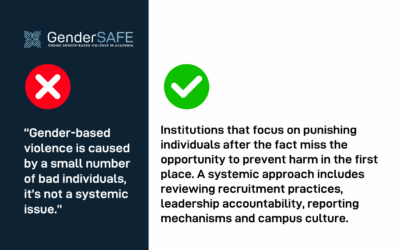What comes to your mind when you think about the word gender-based violence? Sexual harassment or violence? How about psychological violence based on gender? Online violence? Economical, physical, or organisational violence based on gender? According to the Council of Europe, gender-based violence (GBV) is considered “any type of harm that is perpetrated against a person or group of people because of their factual or perceived sex, gender, sexual orientation and/or gender identity”. Gender-based violence occurs in both private and public spheres, and higher education and research institutions are not an exception.
Gender-based violence, a continuum
Gender-based violence is also understood and conceptualised as a continuum whereby seemingly ‘innocent’ or ‘mild’ forms of misconduct when not addressed tend to gradually escalate into more severe and grave forms of violence. On such a continuum, one can think of inappropriate questions about people’s private lives, comments about one’s looks, ‘unintended’ bodily contact, sexist jokes, manoeuvring victims into unwanted ‘intimate’ encounters, and so forth, up to situations that involve physical and/or sexual violence and even rape. ’Violence’ is in this understanding used as the encompassing term that captures all stages of the continuum. Find out more definitions of gender-based violence here.
Zero-tolerance approach to gender-based violence
In order to cultivate an institutional culture in which there is no form of gender discrimination, it is essential that higher education and research institutions do not tolerate any form of gender-based violence.
Because gender-based violence is a continuum, the zero-tolerance approach focuses on capturing the entire spectrum of unacceptable behaviours, starting with and moving on from those instances that are less visible.
In September 2024, the European Commission’s ERA Forum Sub-group on Inclusive Gender Equality published a baseline code of conduct adopting a zero-tolerance approach. In this sense, it considers any instance of gender-based violence as appropriate to address.
Based on a review of existing scholarly debates and insights into the uses of the zero-tolerance approach, the document builds on the following understanding of the Zero-Tolerance approach to counteracting gender-based violence:
1. Clear message:
Zero tolerance sends a clear message that gender-based violence is completely unacceptable at the given institution/in the given area. Such a message can be crucial in creating a culture of coming forward where any form of gender-based violence is regarded as deserving attention, thereby promoting a safer environment built on trust, open communication, accountability, support and resources, and continuous improvement.
2. Strong deterrence:
A zero-tolerance approach can serve as a strong deterrent against gender-based violence, as it ensures that all acts of gender-based violence will be thoroughly investigated and addressed with the sanctions and redress measures that are appropriate to the severity of the abuse.
3. Institutional change:
The deterrence aspect, clear messaging, and accountability can be some of the drivers of institutional change, as adopting a clear stance against gender-based violence in higher education and research institutions would be a significant rhetorical and practical shift from the current state of institutional culture at many institutions.
4. Clarity of intent:
The concept of ‘zero tolerance’ clearly characterises the intent and stance of the institutions in question. It represents a feasible goal, as a zero-tolerance stance does not imply the absolute eradication of gender-based violence, unlike, for example, the phrase ‘ending gender-based violence’, and instead it makes it clear that such behaviour will not be tolerated, meaning that every act of gender-based violence will be taken seriously and thoroughly investigated.
5. Focus on rehabilitation:
In line with the institutional change approach, the focus must also be on rehabilitation and institutional healing.
To summarise:
- A zero-tolerance approach sends a clear message that gender-based violence is completely unacceptable at the given institution/in the given area.
- This approach can serve as a strong deterrent against gender-based violence, as it ensures that all acts of this behaviour will be investigated and addressed with the sanctions.
- In line with the institutional change approach, the focus must also be on rehabilitation and institutional healing.
Better understanding zero-tolerance policies
Zero-tolerance policies are not completely new – they have been discussed since the early 1990s, with varying implementations and criticisms.
GenderSAFE’s deliverable, “Report on Zero-Tolerance Approaches to Gender-Based Violence in Higher Education and Research,” seeks to establish an EU-wide understanding of zero-tolerance policies (ZTA) against gender-based violence, including sexual harassment. Authored by Bondestam, Fikejzová, Linková, and Strid (2024), this comprehensive report offers a brief background and description of the current scholarly debates related to the zero-tolerance approach, followed by a critical analysis of how HEIs in Europe are addressing gender-based violence with this approach, and key conclusions and recommendations. It focuses on two national contexts—Sweden (SE) and Ireland (IE)—chosen for their existing frameworks that reflect zero-tolerance principles. These case studies not only shed light on current practices but also highlight the gaps and challenges that still exist in fully realising a zero-tolerance culture.




